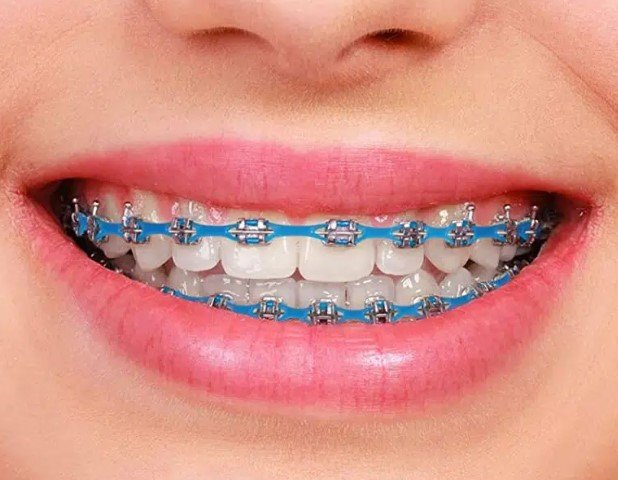Power chain braces are an orthodontic treatment designed to correct dental alignment issues. If you or someone you know is considering getting power chain braces, then this blog is perfect for you. In this post, we will break down everything you need to know about power chain braces. From understanding how they work and the different types available, to exploring the maintenance tips that can help keep your braces in top condition. We’ll also address common concerns such as discomfort and the specific foods to avoid while wearing power chains. So whether you’re a first-timer or a seasoned veteran of dental correction treatments, read on to learn more about power chain braces and how they can help give you the perfect smile.
The Orthodontic Importance of Power Chain Braces
Power chain braces play a crucial role in orthodontic treatment by applying continuous pressure to gradually move teeth into proper alignment. They are essential for creating the right spacing and alignment, closing gaps between teeth, and correcting misalignment. With their versatility, power chain braces allow for individualized treatment objectives to be achieved. However, it is important to maintain good oral hygiene while wearing power chain braces to prevent any potential side effects. Regular brushing and flossing, along with visits to the dentist, will ensure that the power chains, ligatures, and brackets remain in top condition throughout the treatment process. In addition, power chains can also be used to prepare the teeth for other dental procedures such as crowns, fillings, veneers, and even retainers.

Understanding the Role of Power Chains in Dental Correction
Power chains play a crucial role in orthodontic treatment by addressing dental misalignments and malocclusions. There are two types of power chains: elastomeric and metal chains. Proper maintenance is essential for power chains, including regular brushing and flossing. Patients should closely follow their orthodontist’s instructions regarding wear and adjustments. When used effectively in combination with other orthodontic treatments, power chains, such as traditional metal braces, can help achieve optimal dental correction results. It’s important to note that power chains should be used under the supervision of a dentist or orthodontist to ensure safety and effectiveness. By applying constant pressure, power chains aid in the gradual movement of teeth toward proper alignment, resulting in a beautiful, healthy smile.
Who Needs Power Chain Braces?
Power chain braces can be beneficial for individuals who are suffering from various orthodontic problems. These can include overcrowding, spacing issues, or misaligned teeth. A power chain is a series of connected elastic O-rings that are placed around the brackets of the braces. They exert consistent pressure on the teeth, helping to close gaps and align them properly. This can result in a more even and attractive smile. If you have any of these orthodontic issues, it may be worth discussing power chain braces with your orthodontist to see if they are a suitable treatment option for you.
Diving into the Types of Power Chain Braces
When it comes to power chain braces, there are different types that cater to individual preferences. Traditional power chain braces, made from typical elastics or rubber, are commonly used to close gaps between teeth. Clear power chain braces, on the other hand, offer a more discreet look as they are made from clear elastic material. For those who want to add a touch of personalization, colored power chain braces are available in a variety of colors, including silver or smoke-colored power chains which are the most preferred color for stain resistance. You can try a different color every time or get a whole new set if you like. To ensure the effectiveness of power chain braces, regular brushing and flossing, avoiding hard and sticky foods, and attending regular check-ups with your orthodontist are essential.
How do Different Types of Power Chains Work?
Understanding how different types of power chains work can be helpful for those who are undergoing orthodontic treatment with braces. Power chains are elastic or metal chains that connect the brackets of braces, applying consistent pressure to move teeth into alignment. There are two main types of power chains: closed and open. Closed power chains consist of a continuous loop that goes around each bracket, exerting equal force on all the teeth. Open power chains, on the other hand, have gaps between each segment, allowing for individual adjustment of force on specific teeth. The type of power chain used will depend on the specific treatment plan and goals determined by the orthodontist. By understanding how different types of power chains work, patients can have a better understanding of their treatment process and what to expect as they work towards achieving a straighter smile.
Does the Color of Power Chains Matter?
If you’re currently undergoing orthodontic treatment with braces, you may have heard about power chains. These are elastic bands that are used to close gaps between teeth or to align the bite. One common question that many patients have is whether the color of power chains matters. The answer is no, the color of power chains does not affect their functionality. The purpose of power chains is to apply continuous pressure on the teeth, regardless of their color. However, if you want to add a touch of personalization and style to your braces, you can choose power chains in different colors to match your mood or preferences. Just remember to consult with your orthodontist before making any changes to your treatment plan. progress or changes in treatment. Discussing color options with your orthodontist will help you choose the best one for your needs.
How Long are Power Chains Typically Worn?
If you’re undergoing orthodontic treatment with braces, you may be familiar with power chains. Power chains are elastic O-rings that are used to close gaps between teeth or to help align the bite. One common question among patients is how long power chains are typically worn. The answer can vary depending on the specific treatment plan and the individual’s dental needs. In some cases, power chains may only need to be worn for a few weeks, while in other cases, they may need to be worn for several months. Your orthodontist will determine the appropriate length of time based on your unique situation and progress during treatment. It’s important to follow your orthodontist’s instructions and attend regular appointments to ensure that your treatment stays on track and achieves the desired results.
Navigating the Discomfort of Power Chain Braces
Navigating the discomfort of power chain braces requires understanding their differences from traditional braces and the various types available for individual dental needs. Proper oral hygiene is crucial, and regular check-ups with the orthodontist ensure progress and adjustment. To manage discomfort and pain, using wax and over-the-counter pain relievers can be helpful. It’s essential to remember that soreness is temporary, and pain medication like ibuprofen or acetaminophen (OTC) may provide relief. Power chain braces exert continuous pressure and can cause tenderness, but these side effects are short-lived. Maintaining good oral hygiene and seeking professional guidance are key to successfully navigating power chain braces.
Do Power Chains Cause More Pain than Regular Braces?
Many individuals who are undergoing orthodontic treatment with braces may wonder if power chains cause more pain than regular braces. The truth is, the level of discomfort experienced with power chains can vary from person to person. Power chains are elastic or metal ligatures that are used to close gaps between teeth or to align them in a specific way. While they can exert more pressure on the teeth compared to regular braces, this doesn’t necessarily mean that they cause more pain. Some people may experience mild discomfort or soreness after the placement of power chains, especially during the first few days. However, this discomfort typically subsides as the mouth adjusts to the pressure. It’s important to remember that any temporary discomfort experienced with power chains is part of the normal process of orthodontic treatment and should not be a cause for concern. If you have any concerns about your orthodontic treatment, it is always best to consult with your orthodontist for personalized advice and guidance.
Essential Maintenance Tips for Power Chain Braces
To maintain optimal oral hygiene with power chain braces, regular brushing and flossing are crucial. It is essential to avoid hard, sticky, and chewy foods as they can damage the braces and cause discomfort. Regular checkups with your orthodontist are necessary to ensure that the braces are working correctly. If you notice any broken or loose brackets or wires, it is important to contact your orthodontist immediately. Additionally, make sure to properly store and clean any additional accessories, such as rubber bands or headgear, to prevent contamination or damage.
The Role of Brushing in Preventing Decay with Power Chains
Maintaining good oral hygiene habits is crucial to prevent tooth decay when wearing power chains during orthodontic treatment. Regular brushing is essential in removing plaque and keeping gums healthy. By employing the proper brushing technique, power chains can effectively close gaps and align teeth. It’s important to remember to brush gently around the power chains to avoid any discomfort or irritation. For specific instructions on brushing with power chains, consult your orthodontist. By incorporating brushing into your routine, you can ensure that your power chains are working their best to achieve a beautiful and healthy smile.
How to Keep Your Power Chains in Top Condition?
To keep your power chains in top condition and prevent any potential damage to your teeth and gums, it is crucial to maintain good oral hygiene. Follow your orthodontist’s instructions for maintenance and be diligent in practicing proper brushing and flossing techniques. Avoid sticky foods that can cause plaque buildup and be cautious when flossing around the power chains. If you experience any issues or discomfort, schedule an appointment with your orthodontist. Remember, poor oral hygiene, even for a short period of time, can extend your treatment time and potentially harm your dental health.
Are there any Specific Foods to Avoid while Wearing Power Chains?
To protect your power chains and prevent root resorption, it’s important to avoid chewy or sticky foods that can damage them. Additionally, steer clear of hard foods like ice or hard candies, as they can cause damage to the power chains and brackets. Limit sugary foods and drinks to reduce the risk of tooth decay. Be cautious with crunchy foods that may put excessive pressure on the power chains. Consult your orthodontist for a detailed list of foods to avoid.
Can anyone Adjust Power Chains or Does it Require a Professional?
Adjusting power chains should only be done by a qualified orthodontist. Attempting to do it yourself can lead to complications or damage. Orthodontists have the expertise and tools to make proper adjustments for optimal treatment. Regular visits are important for monitoring progress and addressing any issues or discomfort.
Conclusion
In conclusion, power chain braces play a crucial role in orthodontic treatment by helping to align teeth and correct bite issues. There are different types of power chain braces available, each with its own unique characteristics and benefits. It is important to understand the purpose and function of power chains in dental correction. While power chains may cause discomfort initially, proper maintenance and care can help alleviate any pain or discomfort. Regular brushing and avoiding certain foods can help prevent decay and keep the power chains in top condition. If you have any concerns or need adjustments with your power chain braces, it is best to consult a professional orthodontist. Remember, the key to successful orthodontic treatment is consistent care and following the guidance of your orthodontist.
Frequently Asked Questions
[faq-schema id=”1449″]








